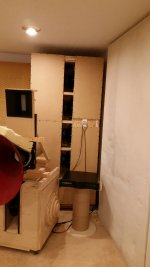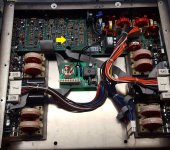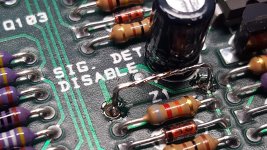Hi folks,
I have been working in my home theater to replace the Martin Logan Dynamo 1000 sub with diy ones. After a bit of reasearch, I settled onthe Dayton Ultimax UM15-22 which are 15 inch dual voice coil 800W drivers. I have a couple of friends that have pro power amps and I decided to go with a Crown K2 because it has no fan which is great for HT use.
I found a K2 amp in a pawn shop for a good price, but it needed a bit of love so i stripped the electronics and send it for a powder coat. I was not able to take of the face overlay sticker withouth damaging them so I redid the layout and laser engraved some durablack sheets to replace the stickers. After seeing that my friend wanted to do the same so we did the same treatment to his but wil silver stickers. See pictures attached!
Afterwards I ran some simulations with winISD to compare the Sealed vs Ported enclosure. 9cu ft ported tune at 19Hz vs 4.5 cu ft sealed enclosure. It obviously the sealed showed a more promessing response... but what the heck... let's build them both and see how they compare in the real world!
So i did just that and was surprised to see how the results are close to the simulations! The ported enclosure (9 cu ft), although twice the size of the sealed (4.5 cu ft) one, won the contest hands down. The bump arount 45Hz is my room mode that I haven't treated yet...I just need to build a second one and finish them up.
So there it is, hope you enjoy!
I have been working in my home theater to replace the Martin Logan Dynamo 1000 sub with diy ones. After a bit of reasearch, I settled onthe Dayton Ultimax UM15-22 which are 15 inch dual voice coil 800W drivers. I have a couple of friends that have pro power amps and I decided to go with a Crown K2 because it has no fan which is great for HT use.
I found a K2 amp in a pawn shop for a good price, but it needed a bit of love so i stripped the electronics and send it for a powder coat. I was not able to take of the face overlay sticker withouth damaging them so I redid the layout and laser engraved some durablack sheets to replace the stickers. After seeing that my friend wanted to do the same so we did the same treatment to his but wil silver stickers. See pictures attached!
Afterwards I ran some simulations with winISD to compare the Sealed vs Ported enclosure. 9cu ft ported tune at 19Hz vs 4.5 cu ft sealed enclosure. It obviously the sealed showed a more promessing response... but what the heck... let's build them both and see how they compare in the real world!
So i did just that and was surprised to see how the results are close to the simulations! The ported enclosure (9 cu ft), although twice the size of the sealed (4.5 cu ft) one, won the contest hands down. The bump arount 45Hz is my room mode that I haven't treated yet...I just need to build a second one and finish them up.
So there it is, hope you enjoy!
Attachments
-
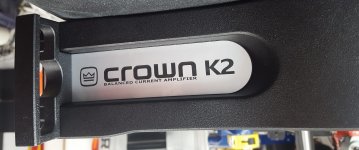 20181230_225955.jpg968.2 KB · Views: 541
20181230_225955.jpg968.2 KB · Views: 541 -
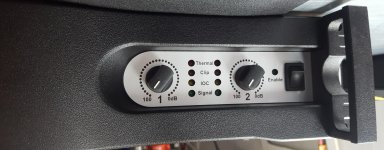 20181230_225948.jpg982.6 KB · Views: 504
20181230_225948.jpg982.6 KB · Views: 504 -
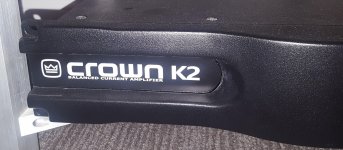 20190102_121810.jpg670.4 KB · Views: 471
20190102_121810.jpg670.4 KB · Views: 471 -
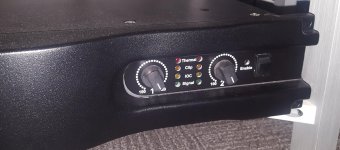 20190102_121816.jpg678.3 KB · Views: 480
20190102_121816.jpg678.3 KB · Views: 480 -
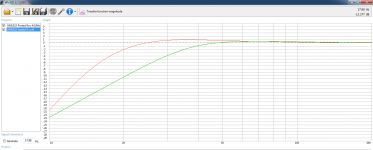 UM15 Ported vs Sealed simulation.png59.2 KB · Views: 489
UM15 Ported vs Sealed simulation.png59.2 KB · Views: 489 -
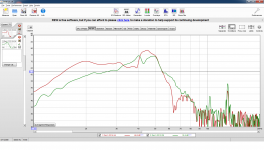 UM15 Ported vs Sealed.png156.4 KB · Views: 262
UM15 Ported vs Sealed.png156.4 KB · Views: 262 -
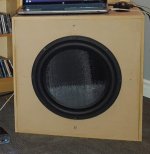 20181206_192930.jpg321.1 KB · Views: 210
20181206_192930.jpg321.1 KB · Views: 210 -
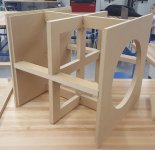 20181125_152422.jpg419.6 KB · Views: 239
20181125_152422.jpg419.6 KB · Views: 239 -
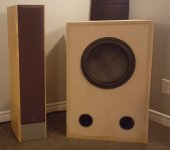 20181015_073425.jpg381.9 KB · Views: 250
20181015_073425.jpg381.9 KB · Views: 250 -
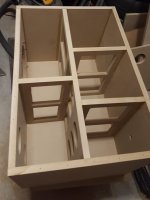 20181009_001808.jpg344.3 KB · Views: 260
20181009_001808.jpg344.3 KB · Views: 260
Last edited:
Nice work. I have a K2 running my single Stereo Integrity HST-18mkii in 4 cu ft sealed and am very happy with it. Nice amp. Got mine from a friend who owns a night club and after years of abuse and smoky dusty conditions it is still chugging along without a problem.
Nice work.
The ports seem a bit small for a high excursion subwoofer, what is the maximum air velocity?
The ports seem a bit small for a high excursion subwoofer, what is the maximum air velocity?
They are 2 x 4 in ID ports. I wanted to go larger but the length was a problem. Max air velocity is 1.6 m/s @16.5 Hz. I ran some sine tones down to 10 Hz and I could hear a bit of whisling but the ports are not flared yet. I'm going to run the router on the next version and see if it eliminates the whisling but honestly, I haven't heard anything with music or any movies yet.
Nice work. I have a K2 running my single Stereo Integrity HST-18mkii in 4 cu ft sealed and am very happy with it. Nice amp. Got mine from a friend who owns a night club and after years of abuse and smoky dusty conditions it is still chugging along without a problem.
Yeah, those amps are real tanks! I have never heard a bad review on them. I even talked to someone that tried it on some high end electrostatic Martin Logan's and he said it was an excellent amp for the price. The rest of my system is Rotel processor, Rotel amp, and JM Lab chorus speakers. The subs and amp fits right in!
Main issue with the K2 is the signal sensing circuitry to make it more efficient in power usage. If you have little to no signal, the amp will shut off. This can be a pain for quieter passages as the amp might not see enough signal to stay active.
Later,
Wolf
Later,
Wolf
They are 2 x 4 in ID ports. I wanted to go larger but the length was a problem. Max air velocity is 1.6 m/s @16.5 Hz. I ran some sine tones down to 10 Hz and I could hear a bit of whisling but the ports are not flared yet. I'm going to run the router on the next version and see if it eliminates the whisling but honestly, I haven't heard anything with music or any movies yet.
I suspect you've only checked air velocity at 1w input.
Try 500w.
I'd say the ports are definitely on the small side. Fine if you're not going to drop a load of power in there, but if you are, I'd be looking at a big folded port, or maybe morph into a tapered transmission line.
Chris
There is a resistor inside the K1-K2 that can be changed to keep them on.
The very first units would drop out in about five seconds without signal, this was changed on later units to stay on for almost one minute.
I can link the details if you would like.
Barry.
The very first units would drop out in about five seconds without signal, this was changed on later units to stay on for almost one minute.
I can link the details if you would like.
Barry.
is an excellent idea. Sure enough though, once in a while with a very low level, it shuts down. The flip side is, that I never turn the power off on the front panel.
You can add a jumper on the input board to suppress the sleep mode function. The down side is that the amp will draw about 80W on idle instead of 10W for sleep mode. The amp will get pretty warm to the touch after an hour or two.
I have done this mode for my amp and my friends two amp. If you are comfortable doing a simple solder you'll be ok. If you don't please ask someone who knows how to handle a soldering iron. See pictures attached, Crown designed that feature so it's not a hack look for the Z1 reference designator on the board, that's where the jumper goes.
Attachments
I suspect you've only checked air velocity at 1w input.
Try 500w.
I'd say the ports are definitely on the small side. Fine if you're not going to drop a load of power in there, but if you are, I'd be looking at a big folded port, or maybe morph into a tapered transmission line.
Chris
Oups... you right, I originally ran all my sims at 400 W but for some reason the project file got corrupted so I made a new project and did not update the input signal parameter... it's more around 83 m/s. Is that too high? If so, what would be an acceptable threshold? I am going to cut a second box to replace the sealed enclosure and since I can cut it with a cnc, it not much more work to make 2 so that they are identical!
Oups... you right, I originally ran all my sims at 400 W but for some reason the project file got corrupted so I made a new project and did not update the input signal parameter... it's more around 83 m/s. Is that too high? If so, what would be an acceptable threshold? I am going to cut a second box to replace the sealed enclosure and since I can cut it with a cnc, it not much more work to make 2 so that they are identical!
Correction, the velocity is 36 m/s.
83m/s is very high, although bear in mind that will only occur with a 400W sine tone at the port tuning frequency.
Are you planning on running the sub to full power?
Chris
Are you planning on running the sub to full power?
Chris
Max. velocity depends on frequency, port diameter, flare radius and how much the chuffing noise is masked by other sounds. See Flare-it - Free Speaker Design Software for a calculator.
According to the calculator a 4" unflared port starts to chuff at 4-6 m/s at 20 Hz and the core limit (beyond which the port no longer functions as a port) is 20-31 m/s.
According to the calculator a 4" unflared port starts to chuff at 4-6 m/s at 20 Hz and the core limit (beyond which the port no longer functions as a port) is 20-31 m/s.
Last edited:
83m/s is very high, although bear in mind that will only occur with a 400W sine tone at the port tuning frequency.
Are you planning on running the sub to full power?
Chris
Correction, the velocity is more around 36 m/s at 16 Hz. Here is the graph from 10 Hz to 200 Hz.
To be honest, I don't know what will be the power that I'm going to run it at. My Rotel Amp is 5 x 100W in my JM Labs, and I want to have a good balance between the subs and the rest of the system. When listening to music or showing off, of course i'm going to crank it up but I don't have alot of music going lowe than 25Hz so I doubt that will be an issue.
Attachments
Max. velocity depends on frequency, port diameter, flare radius and how much the chuffing noise is masked by other sounds. See Flare-it - Free Speaker Design Software for a calculator.
According to the calculator a 4" unflared port starts to chuff at 4-6 m/s at 20 Hz and the core limit (beyond which the port no longer functions as a port) is 20-31 m/s.
I have two 4 in port and I will flare them inside the enclosure and outside. I haven't done it yet because I wanted to compare closed vs vented as a first quick step. Looking at the graph, I'm right at 20 m/s @ 25 Hz.
Awesome builds! Thanks for sharing. As a rough guide, you'll find some people recommend limiting port velocity to 10% of speed of sound e.g. approx 34 m/S. Some say 5% max e.g. 17m/S.
In reality there are a lot of factors to consider. Best site I've found for port velocity is Port Flares
In reality there are a lot of factors to consider. Best site I've found for port velocity is Port Flares
Just noticed someone had already posted the calculator above. Tables in the link I posted are handy reference for various port sizes and flare size.
At from "chuffing" there are other matters to consider, such as vent compression at high SPL levels. Aiming for a peak that doesn't exceed 17 m/s is a good idea, but for my last build I measured up to 2dB of compression at Fb with a vent design that theoretically reached a peak of only 8.5 m/s.
Have any of you guys tried to put the port on the top of the enclosure? I'm trying to limit the port velocity, but putting 2 6 inch ports or 3 4 inch port would required more depth to the enclosure and I don't want to go deeper. I wouldn't mind using the height of the enclosure and have them on the top. I just don't know what it would make difference sound wise. I have mostly seen ports on the front or in the back. I don't like the idea of having an elbow in the port as they are not smooth all the way...
- Home
- Loudspeakers
- Subwoofers
- Home theater subwoofers with UM15-22 drivers and Crown K2 amp
